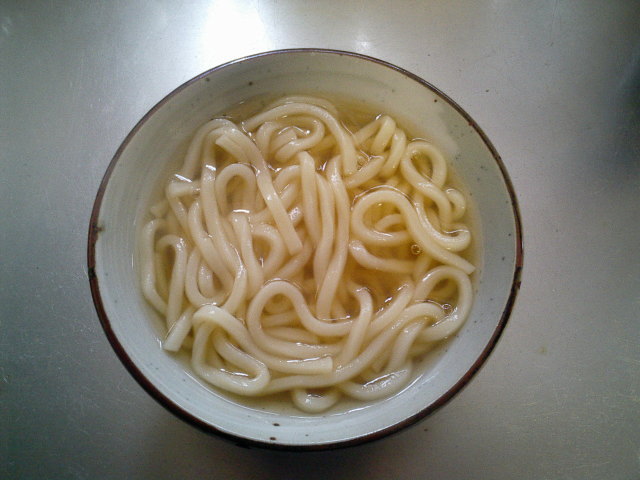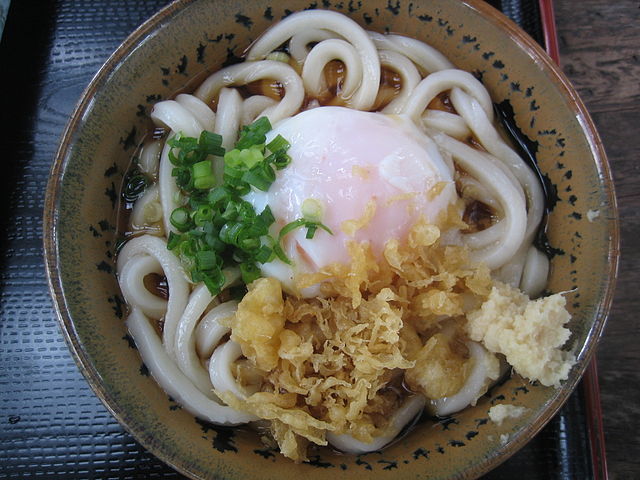| News |
Udon noodles
by Raphael
Udon, the thick, white noodles made from wheat flour, are some of the most popular noodles in Japan. First invented in the 18th century, these noodles became almost as popular as rice by the end of the Edo period. With many local variations in flavor, presentation, and even ordering style, this cheap, easy-to-eat food can be found almost everywhere in Japan. Udon shops range from fast-food-type eateries for customers who can only spare a few minutes, to chic, modern restaurants aimed at upscale clientele.

A typical udon meal can come in a variety of styles. One style consists of freshly boiled noodles which are dipped in a warm, strongly-flavored sauce made from seaweed, soy sauce, and sardines. Another style involves dipping cold noodles into a cold sauce, which emphasizes the firm, chewy texture of the thick noodles. Udon can also be served in a broth made of a diluted form of the dipping sauce. This soup-like dish is often topped with tempura or other foods.
Whatever the style, udon noodles are always made of just wheat flour, salt, and water. The water is salted first to make sure that the gluten in the wheat will firm up and make the noodles pleasantly chewy. However, the amount of salt used has a big effect on how the noodles will turn out and thus must be adjusted to match the day’s weather and humidity. Udon noodles are then hand mixed, and finally trampled under a large mat to further enhance the stickiness of the gluten. The dough is allowed to rest overnight, then rolled out with a rolling pin to the perfect thickness by a skilled noodle maker. Finally, the noodles are sliced into strands, briefly boiled, and rinsed in cold water. The rinse helps keep the noodles from getting slimy, and the end product is a batch of firm, gleaming white udon noodles.
Other types of udon noodles exist as well. For example, there is a green kind of udon made from the leaves of the daikon plant, or Japanese radish, and there is a purple kind made from purple Japanese sweet potatoes. These noodles are occasionally mixed in with the traditional white noodles and offer a subtle flavor contrast. The sauce may have additional ingredients as well, such as pork meat or burdock root, which enhance the flavor of the meal.
Udon noodles are a classic Japanese food that descend from some of the first noodles brought to Japan from China by a returning diplomat in the 8th century. By the 1300s, udon was commonly eaten by Buddhist monks, but common people did not get the opportunity to enjoy udon because they did not own the stone mortars needed to grind wheat into flour. In those days, mortars were only used by the elite, mostly for grinding matcha tea. However, civil war resulted in a flurry of castle-building, after which many stonemasons were out of work. The unemployed masons made mortars, and as more people began to own them, wheat cultivation was also spreading amongst farmers, who needed crops to help feed themselves after large portions of their rice crop were taken as taxes to support local warlords. Armed with wheat and mortars, common people were thus able to make udon for themselves.
The Gotou udon served in the Gotou Islands of Nagasaki Prefecture are the oldest version of udon served in Japan today. These thinner, rounder udon are cut in a spiral pattern from round dough and stretched by hand, then further stretched by means of bamboo poles, and resemble early hand-pulled noodles. Other regional specialties exist, too. In Nagano, the 400 year-old oshibori udon is made with squeezed daikon juice, which provides a spicy folk remedy for colds. Yamanashi udon noodles are cooked along with the rich soup that includes pumpkin and carrots. Tochigi New Year udon is quite unique, since the broad, flat noodles are folded into shapes representing the ears of evil spirits. When eaten at the New Year, this udon can protect a family from being heard of by demons, thus preventing bad luck and disaster.
Kagawa Prefecture in Shikoku is known for its “sanuki udon,” a variety popular enough to be found all over the country. Sanuki udon is generally a self-service operation, which offers customers their choice of toppings, as well as any number of other choices as well, such as relative temperature of noodles and soup, and sometimes even the exact blend of broth flavor. Kagawa has an udon culture all its own, with specialized udon taxis, udon museums, and udon restaurants, about half of which are self-serve. Sanuki udon represents a tradition of udon-eating where the customer gets to enjoy the food his or her own way.

Since flour affects the taste and texture of udon noodles, local types of flour all have different characteristics. Lately, disasters in the local Kagawa wheat production, as well as the high quality of an imported grain called ASW, have made Australian flour popular in Japan. However, Japanese strains of wheat have been developed to compete with these foreign grains. Scientists worked hard to discover wheat that would make firm, aromatic flour, and in time they hit upon the “Sanuki Dream 2000” strain, which was made available to local Kagawa farmers. When evaluated against many other types of wheat, the Sanuki Dream variety was found to surpass even ASW in terms of quality, and is now the pride and joy of Kagawa farmers and udon shops alike. Japan has seamlessly integrated tradition and modern science to produce a satisfying delicacy everyone can be proud of.
Photo credits:
- http://commons.wikimedia.org/wiki/File:Kakeudon.jpg
- http://commons.wikimedia.org/wiki/File:Bukkake_udon_by_Ozchin.jpg



















Silvia94
Shuichi02
Xninja7